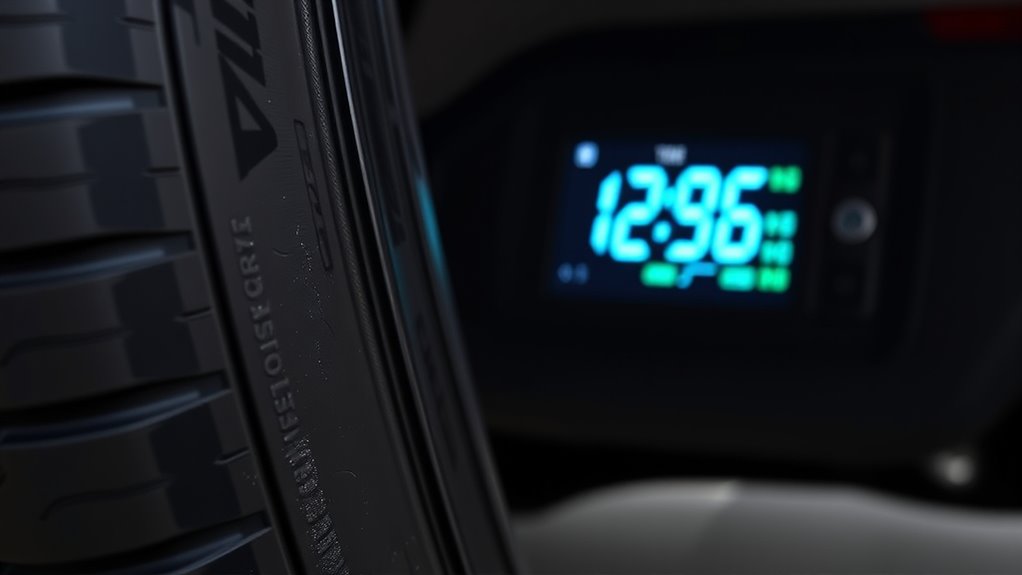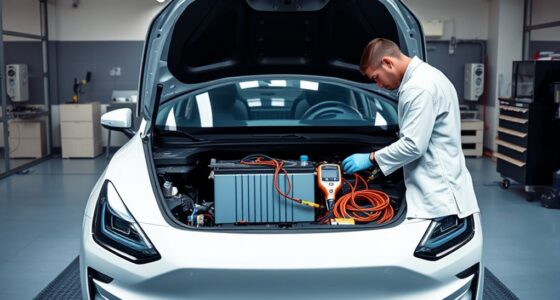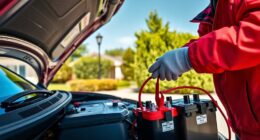To keep your vehicle safe and efficient, maintain proper tire pressure by regularly checking it with a reliable gauge, especially when tires are cold. Your TPMS sensors monitor pressure levels continuously and alert you to any drops or rises outside recommended ranges. Proper calibration of these sensors guarantees accurate readings and avoids false alarms. If you want to understand how to keep your tires properly inflated and maximize your vehicle’s performance, there’s more to discover ahead.
Key Takeaways
- Proper tire pressure improves safety, fuel efficiency, and tire lifespan while preventing accidents and premature wear.
- TPMS continuously monitors tire pressure, alerting drivers to pressure issues for timely correction.
- Calibrating TPMS sensors after rotation or replacement ensures accurate readings and avoids false warnings.
- Check tire pressure monthly with a reliable gauge when tires are cold, matching manufacturer recommended PSI.
- Regular maintenance and sensor checks help maintain optimal tire pressure, vehicle safety, and operational efficiency.

Maintaining proper tire pressure is essential for safe and efficient driving, and understanding how Tire Pressure Monitoring Systems (TPMS) work can help you stay on top of it. Proper tire pressure not only improves fuel economy and tire longevity but also enhances vehicle safety by reducing the risk of blowouts and accidents. To keep your tires in excellent condition, you need to perform regular tire pressure maintenance, which involves checking and adjusting your tire pressure according to your vehicle manufacturer’s specifications. While manual checks are common, many modern vehicles are equipped with TPMS, which continuously monitors your tire pressure and alerts you when it drops below or rises above the recommended range. Becoming familiar with how your TPMS functions, including TPMS sensor calibration, is key for accurate readings and reliable alerts.
Proper tire pressure and TPMS calibration are vital for safety, efficiency, and vehicle longevity.
The TPMS sensor calibration process is fundamental to making sure your system provides precise information about your tire pressure. When tires are rotated, replaced, or serviced, the sensors often need recalibration to align with the vehicle’s onboard computer. This calibration process varies depending on the make and model of your car but generally involves either a manual reset using buttons or a scan tool. If your TPMS warning light comes on unexpectedly or doesn’t turn off after adjustments, it’s a sign that calibration might be needed. Regular calibration ensures that the sensors correctly detect pressure changes, preventing false alarms and promoting safety. Remember, neglecting proper calibration can lead to inaccurate readings, so always follow your vehicle’s owner manual or consult a professional when in doubt.
To maintain tire pressure effectively, you should check your tire pressure at least once a month and before long trips. Use a reliable tire pressure gauge and compare your readings to the recommended PSI listed in your owner’s manual or on the driver’s side door jamb. Adjust the pressure when tires are cold for the most accurate measurement, as driving heats up tires and can give false readings. Incorporating automated monitoring systems like TPMS can greatly enhance your ability to keep tires properly inflated, but it’s important to understand their limitations. Sometimes, sensors can malfunction or lose calibration, leading to incorrect pressure alerts. If you notice your TPMS warning light stays on or blinks, it’s time to inspect, recalibrate, or replace the sensors to make sure your system functions correctly.
Ultimately, understanding the importance of tire pressure maintenance and TPMS sensor calibration empowers you to keep your vehicle running safely and efficiently. Regular checks, proper calibration, and attentive response to alerts help prevent unnecessary wear, improve handling, and save you money on fuel and repairs. Staying proactive with these simple yet essential steps ensures your driving experience remains smooth, safe, and cost-effective.
Frequently Asked Questions
How Often Should I Check My Tire Pressure?
You should check your tire pressure at least once a month to maintain proper tire maintenance and guarantee safety. Regular checks help you follow an inflation schedule that keeps your tires properly inflated, improving fuel efficiency and extending tire life. Additionally, check them before long trips or when there’s a significant temperature change. Keeping an eye on your tire pressure now and then prevents uneven wear and reduces the risk of blowouts.
Can Temperature Changes Affect Tire Pressure?
Think of your tires as balloons that dance to the tune of seasonal fluctuations. When temperatures drop, thermal expansion cools the air inside, causing pressure to dip—like a sigh of relief. Conversely, warmer days cause the air to expand, increasing pressure. These natural changes mean you should check your tire pressure more often during temperature swings to keep your ride smooth and safe.
What Is the Ideal Tire Pressure for My Vehicle?
You should check your vehicle’s recommended tire pressure, usually found in your owner’s manual or on the door placard, to prevent uneven tire wear and improve fuel efficiency. Regularly monitor and adjust your tires with proper inflation tips, ensuring they’re neither under- nor over-inflated. Maintaining the right pressure helps your tires last longer, provides better handling, and keeps you safe on the road.
How Does TPMS Alert Me to Low Tire Pressure?
When your TPMS detects low tire pressure, it uses sensors to monitor each tire’s condition. If a tire’s pressure drops below the recommended level, the sensors send data to your vehicle’s computer. Once the system confirms sensor accuracy, it activates an alert—usually a warning light on your dashboard. This quick notification helps you address the issue promptly, ensuring safe driving and preventing tire damage.
Are There Different TPMS Types and How Do They Work?
You’ll find different TPMS sensor types, like direct and indirect systems. Direct sensors use pressure sensors inside each tire to monitor pressure and send signals to your vehicle’s system. Indirect sensors measure wheel speed differences to estimate pressure changes. Both systems function to alert you when tire pressure drops below safe levels, helping you maintain proper inflation, improve safety, and extend tire life.
Conclusion
Now that you understand tire pressure and TPMS, think of your tires as the heartbeat of your car—keeping them properly inflated guarantees smooth, safe rides. Just like a well-tuned orchestra, maintaining the right pressure creates harmony on the road. Don’t let underinflation or overinflation be the silent thief of your safety. Regular checks and trusting your TPMS keeps your vehicle humming along, turning everyday driving into a seamless, worry-free journey.









